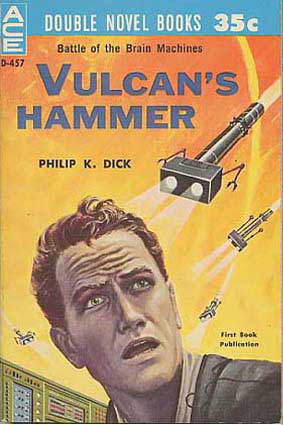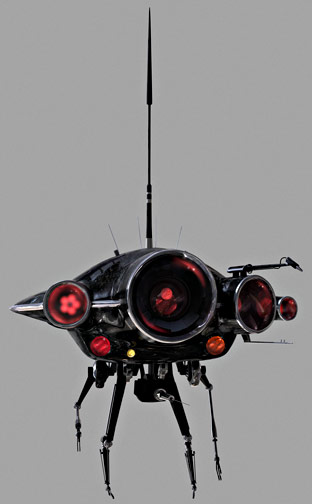Science Fiction
Dictionary
A B C D E F G H I J K L M N O P Q R S T U V W X Y Z
Flying Robot Has An Arm

Take a look at this flying robot created by researchers at the University of Seville.
(Flying robot arm)
"We’ve integrated the control of the arm with the control of the aerial platform itself. It’s necessary to control both at the same time. The robot estimates its position using GPS and a video camera,” explains Aníbal Ollero Baturone, Professor of robotics and unmanned systems at the University of Seville.That helps the flying machine to understand where it is exactly, and look for objects it can recognise and interact with.
“In the past number of years drones have advanced a lot. They have mainly been focusing on data-gathering – they can carry a camera and take images, and so on. And in the last three to four years, new uses related to interaction have been developed,” said Guillermo Heredia, Professor of Robotics and Automatic Control, School of Engineering at the University of Seville.
Flying robots capable of picking up and carrying cargo are a challenge: they need a shifting centre of gravity to counterbalance the load and a very precise and lightweight arm.
“This platform is unique in the world, because it integrates this arm with six degrees of freedom and it allows the hand to have fixed positions in space even if the robot moves,” said Miguel Ángel Trujillo Soto, Research engineer in avionics, FADA-CATEC.
Fans of Philip K. Dick are probably thinking that the surveillance drones from his 1960 novel Vulcan's Hammer are also armed robots.

(robot tracking devices from Vulcan's Hammer)
More recently, the Prowler 1000 exploration droid from Star Wars may have occurred to some sf fans:

Via Euronews.
Scroll down for more stories in the same category. (Story submitted 9/15/2014)
Follow this kind of news @Technovelgy.| Email | RSS | Blog It | Stumble | del.icio.us | Digg | Reddit |
Would
you like to contribute a story tip?
It's easy:
Get the URL of the story, and the related sf author, and add
it here.
Comment/Join discussion ( 2 )
Related News Stories - (" Robotics ")
Artificial Skin For Robots Is Coming Right Along
'... an elastic, tinted material that had all the feel and appearance of human flesh and epidermis.' - Harl Vincent (1934)
Robot Guard Dog On Duty
I might also be thinking of K-9 from Doctor Who.
Wearable Artificial Fabric Muscles
'It is remarkable that the long leverages of their machines are in most cases actuated by a sort of sham musculature...' HG Wells, 1898.
Dancing Robots Taught Dance Moves
'A clockwork figure would be the thing for you...' Jerome K. Jerome, 1893.
Technovelgy (that's tech-novel-gee!) is devoted to the creative science inventions and ideas of sf authors. Look for the Invention Category that interests you, the Glossary, the Invention Timeline, or see what's New.
Science Fiction
Timeline
1600-1899
1900-1939
1940's 1950's
1960's 1970's
1980's 1990's
2000's 2010's
Current News
Replace The Smartphone With A Connected Edge Node For AI Inference
'Buy a Little Dingbat... electropen, wrist watch, pocketphone, pocket radio, billfold ... all in one.'
Artificial Skin For Robots Is Coming Right Along
'... an elastic, tinted material that had all the feel and appearance of human flesh and epidermis.'
Robot Guard Dog On Duty
I might also be thinking of K-9 from Doctor Who.
Wearable Artificial Fabric Muscles
'It is remarkable that the long leverages of their machines are in most cases actuated by a sort of sham musculature...'
BrainBridge Concept Transplant Of Human Head Proposed
'Briquet’s head seemed to think that to find and attach a new body to her head was as easy as to fit and sew a new dress.'
Google's Nano Banana Pro Presents Handwritten Math Solutions
'...copy was turned out in a charming and entirely feminine handwriting.'
Edible Meat-Like Fungus Like Barbara Hambly's Slunch?
'It was almost unheard of for slunch to spread that fast...'
Sunday Robotics 'Memo' Bot Has Unique Training Glove
'He then started hand movements of definite pattern...'
Woman Marries Computer, Vonnegut's Dream Comes True
'Men are made of protoplasm... Lasts forever.'
Natural Gait With Prosthetic Connected To Nervous System
'The leg was to function, in a way, as a servo-mechanism operated by Larry’s brain...'
Spidery 'Walk Me' Toyota Autonomous Wheel Chair Like Star Wars
Walk along with the emperor.
Dancing Robots Taught Dance Moves
'A clockwork figure would be the thing for you...'
Proof Of Robothood - Not A Person
'Who are you people? - Show 'em.'
Indonesian Clans Battle
'The observation vehicle was of that peculiar variety used in conveying a large number of people across rough terrain.'
The 'Last Mile' In China Crowded With Delivery Robots
Yes, it's a delivery robot. On wheels.
Tornyol Microdrone Kills Mosquitoes
'The real border was defended by... a swarm of quasi-independent aerostats.'
